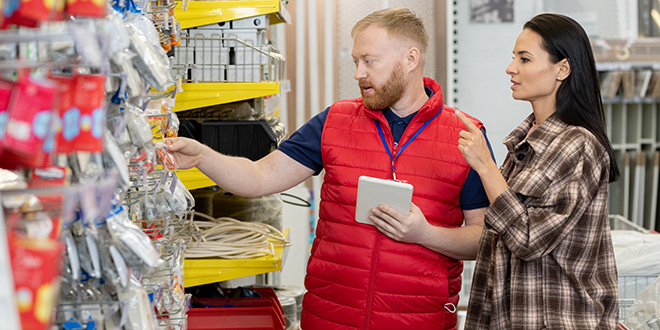Shopping mania: Part of your brain is always browsing

As the holiday season unfolds, shopping reaches its peak. This year, a staggering 197 million people shopped from Black Friday to Cyber Monday, and spent a record $33.6 billion on Black Friday alone.
Behind the shopping frenzy lies a fascinating intersection of brain activity, neuroscience, and economics, as explored by Dr. Uma Karmarkar, a leading expert in neuroeconomics.
Karmarkar investigated the psychological and physical factors that drive consumer behavior, offering insights into why we buy – and how we can make more intentional choices.
“Neuroeconomics is a field of study that uses theories and methods from neuroscience, psychology, and economics to better understand how people make real-world decisions,” said Dr. Karmarkar, an associate professor at UC San Diego.
With a PhD in neuroscience, as well as a PhD in consumer behavior, Dr. Karmarkar bridges the gap between basic brain science and everyday human actions, such as shopping.
Her journey into neuroeconomics began with studying how brain cells process information for tasks like memory and learning. She found that the decision-making process is complex and engaging.
“I found it very exciting that we could build models from brain to behavior on how we make choices about health or career or finances, or even shop for groceries,” said Dr. Karmarkar.
When shopping, our brains engage in multiple processes. The ventral striatum, a key brain region, evaluates how much we like an item, even when we’re not actively shopping.
If we consider making a purchase, additional brain regions help weigh the price, willingness to pay, and overall decision.
Interestingly, these processes remain consistent between in-person and online shopping. However, environmental factors like interacting with physical products or being surrounded by other shoppers can create subtle differences in how decisions are made.
Role of brands in decision-making
Brands play a powerful role in consumer decisions, offering familiarity and confidence. This sense of assurance activates reward centers in the brain.
“These relationships to brands are strong and multi-faceted, but they’re not the same relationships that we have with people,” noted Dr. Karmarkar.
Understanding these distinctions can help consumers recognize how brand loyalty shapes their choices.
Businesses leverage insights from neuroeconomics to fine-tune marketing strategies. For instance, Dr. Karmarkar’s eye-tracking research highlights how product recommendations can influence purchases.
“I’ve also done some work with eye-tracking – that is, measuring what people look at, and for how long – to help know what information they paid attention to or found useful,” said Dr. Karmarkar.
She found that consumers are more likely to buy an item if it is advertised or displayed among other, similar and recommended items on a page.
Dr. Karmarkar used the example of a person searching online for a sweater to purchase. “The presence of matched products on the page helps you feel more engaged with a ‘sweater-specific’ decision,” she explained.
On the other hand, mismatched recommendations, such as unrelated items like earrings or home goods, can distract consumers and make them less likely to buy.
Alternatives for more sustainable joy
The same brain regions that respond to the rewards of shopping also react to other pleasures, suggesting alternatives for more sustainable joy.
“It doesn’t have to be a sacrifice,” said Dr. Karmarkar. Activities like massages or finding “new-to-me” items through secondhand shopping can provide similar satisfaction without the environmental cost of buying new products.
Our craving for novelty often drives the impulse to shop, as the reward from new items can feel more intense than the ongoing enjoyment of what we already own. Recognizing this tendency can help consumers find rewarding alternatives that align with their values.
Becoming a conscious consumer
Dr. Karmarkar emphasizes the importance of intentional shopping, and highlights how the brain plays a key role in making conscious choices.
“To be a more conscious consumer, think about what your goals are before you get into shopping situations,” she advised. Making a list or setting a budget can help curb impulsive buying, as it’s harder to make deliberate choices in the moment.
The research also suggests expanding your “consideration set” – thinking about other ways to spend your money and time. If a product still feels worthwhile after weighing other options, it might be the right choice.
Dr. Karmarkar’s work reveals the intricate interplay between our brains and shopping behaviors. By understanding the science behind our choices, we can navigate the holiday season – and everyday shopping – with greater awareness.
Whether it’s embracing sustainable habits or rethinking our relationship with brands, the journey toward intentional consumption starts with a deeper understanding of ourselves.
This information is published in a report by the Rady School of Management.
Video Credit: Patagonia
—–
Like what you read? Subscribe to our newsletter for engaging articles, exclusive content, and the latest updates.
Check us out on EarthSnap, a free app brought to you by Eric Ralls and Earth.com.
—–
Related
Ravens’ WR Zay Flowers treats students to shopping spree at…
BALTIMORE — A receiver on the field, yet a giver in the world. Baltimore Ravens player Zay Flowers put a smile on many young faces on Monday. Students from th
The best kitchen deals to shop this week, vetted by…
Just when we start to recover from Thanksgiving madness, here comes Christmas, Hanukkah and Kwanzaa! And while the holidays are an exciting time, they can also
5 Key Gifting Trends as Holiday Shopping Wraps Up
This is just a sneak peek at the thousands of consumer insights available to CivicScience clients. Discover more data. With Christmas just over a wee
Millions to Shop on Super Saturday – Hardware Retailing
Around 157.2 million consumers plan to shop the last Saturday before Christmas, according to an annual survey released by the National Retail










